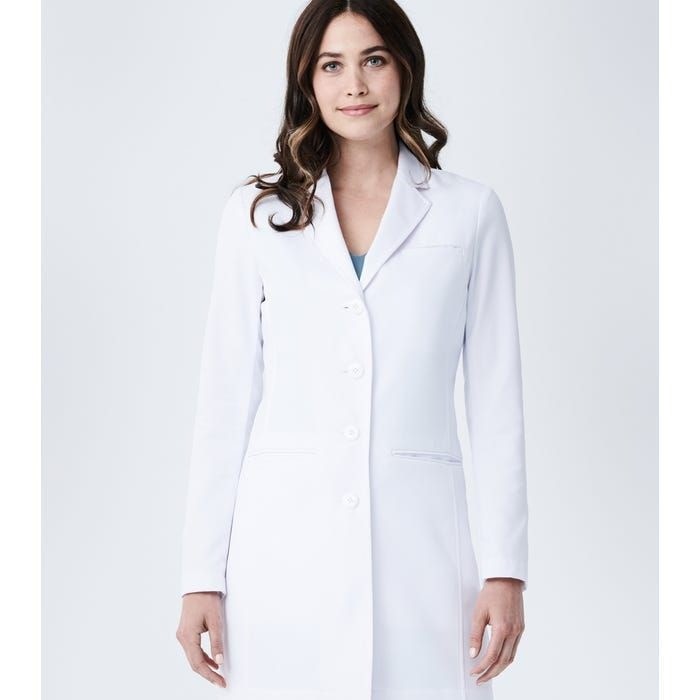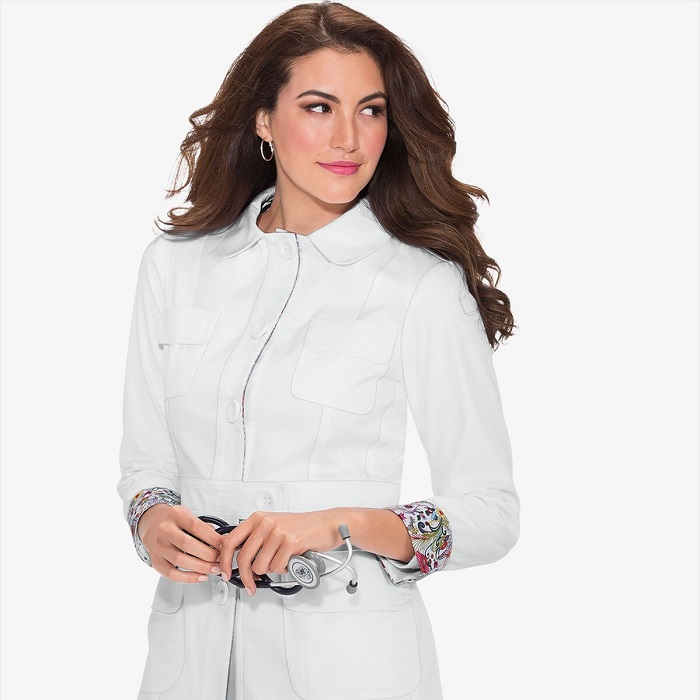Importance of Wearing a Lab Coat
Wearing a lab coat is crucial for anyone working in a laboratory environment. A lab coat serves as the first line of defense against chemical spills, splashes, and accidental contact with hazardous substances. It acts as a protective barrier that can prevent skin exposure to harmful chemicals and infectious agents. Additionally, wearing a lab coat is a symbol of professionalism and dedication in scientific fields. It sets a proper work mindset, promoting meticulous and careful handling of laboratory instruments and samples.
A lab coat also helps to distinguish personnel in the lab. This is important for safety, as it allows for easy identification of individuals who should be in certain areas. Moreover, in the case of emergencies such as a fire or chemical spill, quick recognition of lab staff can facilitate a faster and more organized evacuation.
Finally, lab coats are often designed with utility in mind. They have features such as pockets that allow researchers to carry around small tools and notebooks. This convenience ensures that essentials are at hand when needed, improving efficiency and keeping the focus on the work at hand. For all these reasons, selecting the right lab coat is more than a matter of preference, it’s a crucial aspect of laboratory safety and functionality.
Types of Lab Coats
When it comes to selecting a lab coat, there are several types to consider, each designed for different purposes and laboratory environments.
Standard Lab Coats
Standard lab coats are the most common type found in many labs. They provide a basic level of protection and are suitable for general lab work.
Flame-Resistant Lab Coats
For work with open flames or heat sources, flame-resistant lab coats are essential. They help protect against fire hazards in the lab.
Chemical-Resistant Lab Coats
These lab coats are made to resist chemical spills and splashes, providing an additional layer of protection where harsh chemicals are handled.
Anti-Static Lab Coats
In environments where static electricity could pose a risk, anti-static lab coats are useful. They prevent static build-up and minimize the chances of sparks.
Disposable Lab Coats
Disposable lab coats are ideal for one-time use or when contamination risk is high. They are often used in biological labs and can be easily discarded after use.
When choosing your lab coat, consider the specific risks you face in your work. Each type of lab coat is tailored to particular needs and provides different levels of protection. The right choice keeps you safe and enhances your ability to work effectively.
Material and Durability Considerations

When selecting a lab coat, the material and its durability are critical factors to weigh in. The right material can greatly affect your safety and comfort in the lab. Here’s a breakdown of the key points:
- Fabric Types: Common lab coat materials include cotton, polyester, and blends. Each has its benefits. Cotton is breathable and comfortable. It’s good for general lab work. Polyester is more durable and offers better resistance to wrinkles and shrinkage. Blends mix both properties, providing comfort and durability.
- Durability: Look for lab coats that can withstand multiple washes without degrading. Durability ensures that the lab coat will maintain its protective qualities over time. Check for quality stitching and reinforced seams.
- Resistance to Wear and Tear: The material should hold up against repeated use and exposure to lab conditions. If you work with abrasive materials or equipment, a thicker, more resistant fabric will be required.
- Ease of Cleaning: Given the likelihood of contamination, you’ll want a lab coat material that is easy to clean and can tolerate disinfectants and sterilization procedures.
- Safety Requirements: If you’re handling flammable materials, a flame-resistant fabric is a must. For chemical work, material that resists chemical penetration will offer added security.
Choose a lab coat that matches the durability needs of your lab tasks. Always consider the potential hazards when deciding on material type. Remember, a lab coat is not just a uniform; it’s a key piece of personal protective equipment that must perform under demanding conditions.
Fit and Comfort
Ensuring a proper fit and comfort of a lab coat is essential for day-long wear. A well-fitting lab coat boosts mobility and does not hinder movement, which is vital when performing various tasks in the lab. Here’s what to consider:
- Size Matters: Measure yourself before buying a lab coat. Make sure there’s enough room to move freely, especially in the shoulders and arms.
- Length: Choose a coat length based on your height and preferences. Some prefer a longer coat for more coverage, while others opt for shorter ones for ease of movement.
- Sleeve Length: The sleeves should be long enough to protect your arms, but not so long that they interfere with your hands or lab equipment.
- Vents and Pleats: Look for back vents or pleats that allow for better movement, especially when sitting or bending.
- Adjustments: Features like adjustable back belts or buttons can help cinch the coat for a better fit, enhancing both appearance and comfort.
- Fabric Weight: The weight of the fabric contributes to comfort. Lighter materials are cooler to wear, while heavier ones can offer more durability and protection.
Comfort also affects safety. A coat that fits well ensures that loose fabric won’t catch on equipment or drag through substances. It’s a balance: the right lab coat should be comfortable enough not to distract you, but protective enough to keep you safe. When selecting a lab coat, try it on with any clothing you’d normally wear underneath to ensure a good fit.
Features to Look For

When shopping for the perfect lab coat, assessing its features is key. This ensures you get the best blend of safety, utility, and efficiency. Focus on these details:
- Pockets: Multiple pockets are a must. They should be large enough for tools and notebooks.
- Closures: Strong, easy-to-use buttons or snaps will keep your coat secure.
- Collar Design: A collar can provide extra protection against splashes to the neck area.
- Cuffs: Elastic or knit cuffs offer added safety by fitting snug around wrists.
- Color and Style: While white is traditional, other colors might be required for specific tasks or roles.
- Label Space: A place for your name or ID badge helps distinguish your coat.
- Built-in Technology: Some coats come with repellent coatings or RFID tags for tracking.
Every detail of a lab coat can enhance your work experience. Choose features that align with your lab activities. From strong stitching to safety-enhancing cuffs, these aspects can make a significant difference in your routine.
Safety Standards and Compliance
Ensuring your lab coat meets safety standards is vital. It adds to your confidence and compliance in the lab. Let’s discuss the key compliance aspects you should check:
- OSHA Regulations: The Occupational Safety and Health Administration (OSHA) sets guidelines. Your lab coat should comply with their standards for protective clothing.
- ANSI Standards: The American National Standards Institute (ANSI) specifies safety requirements. Look for lab coats that meet ANSI standards relevant to your field.
- NFPA Codes: The National Fire Protection Association (NFPA) provides codes for fire safety. For flammable work settings, a lab coat that adheres to NFPA codes is crucial.
- ISO Certifications: The International Organization for Standardization (ISO) ensures quality. Certified lab coats meet international safety and quality benchmarks.
- CE Marking: In Europe, CE marking indicates conformity with health, safety, and environmental standards. Check this if you work in or with European labs.
- Industry-Specific Requirements: Depending on your work, your lab coat might need to meet additional standards.
Always confirm that your lab coat adheres to applicable standards. Check labels and product descriptions for these certifications. Safety compliance is non-negotiable. It ensures you work under the highest safety measures. Your lab coat is not just an item of clothing but an essential safety tool. Choose wisely and stay informed on the latest safety regulations.
Care and Maintenance

Proper care and maintenance of your lab coat are essential to prolong its lifespan. Regular maintenance ensures the coat continues to offer protection and remains in good condition. Here are the key points to keep your lab coat in top shape:
- Washing Instructions: Follow the manufacturer’s guidelines for washing. Use appropriate detergents and avoid bleach if the material is not compatible.
- Inspection: Examine your coat before and after washing. Look for signs of wear, such as thinning fabric or loose buttons.
- Repair: Mend any small rips or tears immediately to prevent them from getting larger.
- Avoid Contaminants: Store your coat in a clean, dry place to prevent contamination from dust or chemicals.
- Regular Replacement: Even with proper care, replace your coat if it shows signs of significant wear or if it fails to protect you as intended.
- Retention of Protective Features: Make sure that any maintenance process does not degrade the protective features of your coat, such as flame resistance or chemical repellency.
By keeping these care and maintenance tips in mind, you can ensure your lab coat continues to serve its purpose effectively. Remember, a well-maintained lab coat not only protects you but also embodies your commitment to safety and professionalism in the laboratory.
Tips for Purchasing Lab Coats Online
Purchasing your lab coat online may seem daunting, but it can be a breeze with the right approach. Follow these tips to make a smart, safe choice from the comfort of your home.
- Check Reviews: Read comments from other customers. Look for feedback on size, material, and durability.
- Confirm Sizing Charts: Pay attention to the provided sizing charts. Measure your body to match the size that will fit you best.
- Understand Return Policies: Be clear on the return policy. In case of size or material issues, know you can exchange or return the coat.
- Trustworthy Suppliers: Order from reputable suppliers. Ensure they offer high-quality coats that meet safety standards.
- Question Product Descriptions: Scrutinize the descriptions. Make sure they list all the features and comply with the safety norms you require.
- Seek Advice: If uncertain, get recommendations. Ask colleagues or look for industry forums.
By keeping these tips in mind, you’ll find the perfect lab coat online with ease. Remember, the goal is to get a coat that ensures safety, comfort, and durability. When well-executed, online shopping can provide you with a broad range of options and convenient delivery.


